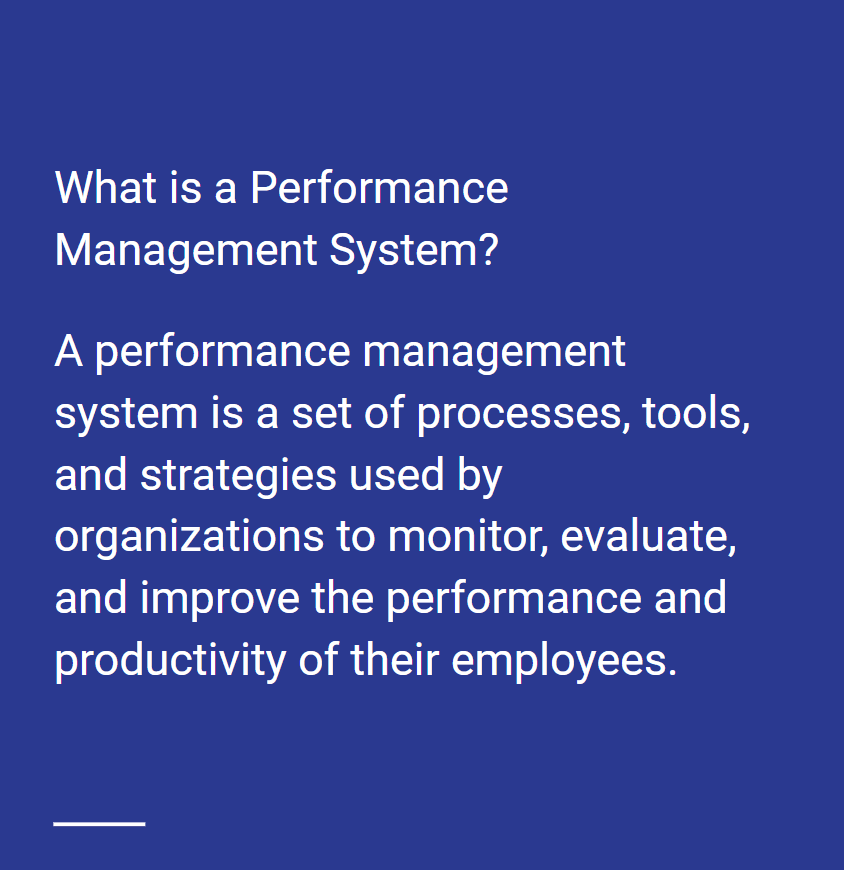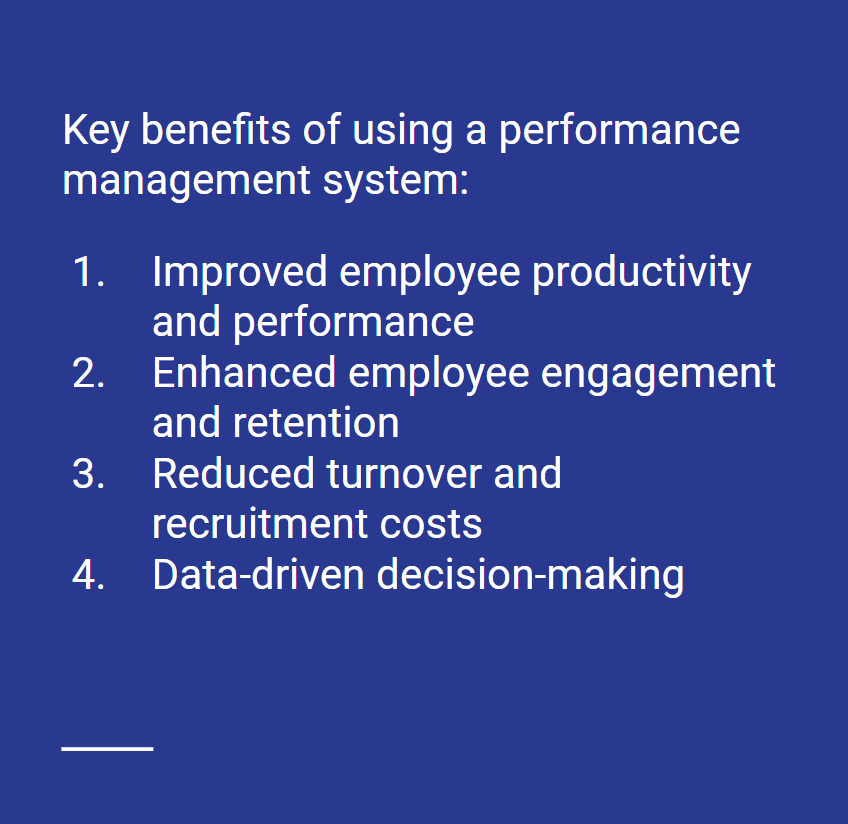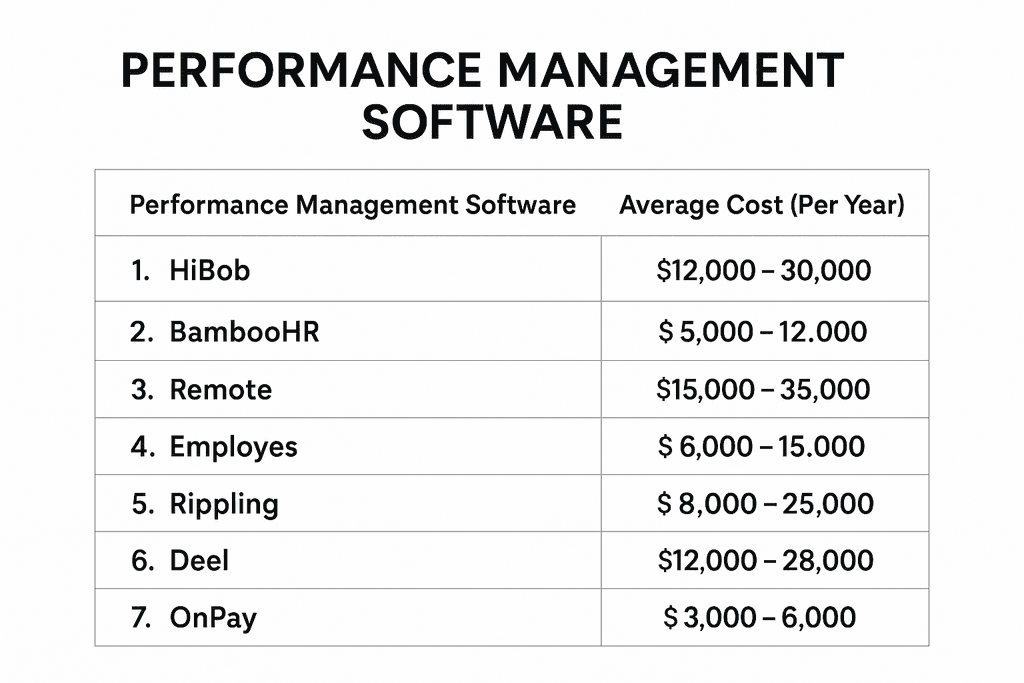A performance management system is a set of processes, tools, and strategies used by organizations to monitor, evaluate, and improve the performance and productivity of their employees. It involves setting clear expectations, establishing goals and objectives, tracking progress, providing feedback, and rewarding or recognizing achievements. A performance management system typically includes various components such as performance reviews, goal setting, development plans, performance tracking, and feedback mechanisms.
A well-designed performance management software can help organizations improve employee engagement, productivity, and overall performance. It can also enable organizations to identify and address performance gaps, recognize high performers, and support employee development and growth. Ultimately, an effective performance management system can contribute to a culture of continuous improvement, accountability, and success within an organization.

Performance management software costs vary based on the number of users, the features you want, and the complexity of your organization. Typically the cost is based on the number of Users. This is the number of people who will use the software. If you are in a small company with only a few employees, you may only need a handful of licenses. If you have a large company with thousands of employees, you may need hundreds of licenses. This is why the costs for performance management software can vary so much.
Pricing for performance management software is just one aspect of the overall cost. Other costs include training and support, which can range from $5000 to $30,000 depending on your requirements.
Performance Management Software: Return on Investment (ROI)
A performance management system is a strategic investment that can yield significant returns for organizations. The return on investment (ROI) of a performance management system can be measured in various ways, including improved employee performance and productivity, streamlined processes, reduced turnover and costs associated with poor performance, and enhanced organizational performance.

Firstly, a performance management system helps improve employee performance and productivity. Clear goal-setting, ongoing feedback, and regular performance evaluations provided by a performance management system can help employees understand their roles and expectations, identify areas for improvement, and align their efforts with organizational objectives. As a result, employees are likely to be more engaged, motivated, and productive, leading to increased individual and team performance.
Secondly, a performance management system can streamline performance management processess, saving time and resources. Automation of workflows, real-time tracking, and centralized data management provided by a performance management system can reduce administrative burdens associated with manual evaluations, paper-based systems, and multiple spreadsheets. This allows HR and management teams to focus on strategic initiatives, such as talent development, succession planning, and performance improvement plans, leading to more efficient and effective performance management practices.
Thirdly, a performance management system can help reduce turnover and costs associated with poor performance. By identifying performance gaps, providing feedback, and offering opportunities for development and improvement, a performance management system can help prevent or address performance issues before they escalate and result in turnover or costly turnover-related expenses. Additionally, a performance management system can support fair and consistent evaluations, mitigating potential bias or discrimination in performance evaluations, which can lead to legal or reputational costs.
Lastly, a performance management system can contribute to enhanced organizational performance. By aligning individual and team performance with organizational goals, identifying and rewarding top performers, and identifying skill gaps and development opportunities, a performance management system can help organizations optimize their talent management strategies. This can result in improved overall organizational performance, increased customer satisfaction, and a competitive advantage in the market.
In conclusion, the ROI of a performance management system can be substantial for organizations. It can lead to improved employee performance and productivity, streamlined processes, reduced turnover and costs associated with poor performance, and enhanced organizational performance. By carefully evaluating the costs and benefits of a performance management system and selecting the right solution that aligns with organizational needs, organizations can optimize their performance management practices and drive better results.
Average cost of a Performance Management System
The average cost can vary greatly depending on several factors such as the size of the organization, the complexity of the system, the features and functionalities included, and the vendor or provider chosen. Generally, performance management systems can be categorized into three types: basic, mid-range, and advanced.
Basic performance management systems are typically more affordable and may offer basic features such as goal setting, performance evaluations, and feedback. They may be suitable for small businesses with limited budgets or organizations that are just starting out with performance management. The average cost of a basic performance management system can range from $1,000 to $5,000 per year.
Mid-range performance management systems usually offer more robust features such as advanced analytics, performance tracking, and development planning. They may also have additional integrations with other HR or talent management tools. The average cost of a mid-range performance management system can range from $5,000 to $15,000 per year, depending on the number of users and features included.
Advanced performance management systems are comprehensive and may include features such as 360-degree feedback, succession planning, and performance coaching. These systems are typically designed for larger organizations with more complex performance management needs. The average cost of an advanced performance management system can range from $15,000 to $50,000 per year or more, depending on the size of the organization and the features included.

It's important to note that these are rough estimates and the actual cost of a performance management system may vary depending on various factors. Organizations should carefully evaluate their performance management needs, budget, and priorities when selecting a system that best fits their requirements and resources. Additionally, it's advisable to request quotes from different vendors and compare the features, functionalities, and pricing to make an informed decision.
Here's a table showcasing the average cost of performance management systems for the top 10 performance management software in 2025:
| Performance Management Software | Average Cost (Per Year) |
|---|---|
| 1. HiBob | $12,000 - $30,000 |
| 2. BambooHR | $5,000 - $12,000 |
| 3. Remote | $15,000 - $35,000 |
| 4. Employes | $6,000 - $15,000 |
| 5. Rippling | $8,000 - $25,000 |
| 6. Deel | $12,000 - $28,000 |
| 7. OnPay | $3,000 - $6,000 |
What are some alternatives to performance management systems?
Traditional performance management systems may not always be the best fit for every organization or may not align with their unique needs and culture. Fortunately, there are several alternative approaches to performance management that organizations can consider:
Continuous Feedback and Coaching: Instead of relying on annual or periodic performance reviews, organizations can adopt a culture of continuous feedback and coaching. This approach involves regular check-ins between managers and employees, ongoing feedback on performance, and coaching on skills development. This allows for timely recognition of achievements, identification of areas for improvement, and immediate course correction, leading to more agile and adaptive performance management practices.
Goal Setting and OKRs: Another alternative to performance management systems is a goal-setting approach, often using Objectives and Key Results (OKRs). This approach involves setting clear and measurable objectives that align with organizational goals and regularly tracking progress towards these objectives. It encourages a results-oriented mindset, fosters accountability, and provides a framework for aligning individual and team efforts with organizational objectives.
Talent Development and Growth Plans: Organizations can also focus on talent development and growth plans as an alternative to traditional performance management systems. This approach involves identifying employees' strengths and areas for development, creating individualized development plans, and providing resources and opportunities for skill-building and career advancement. This approach emphasizes employee growth and development, encourages continuous learning, and promotes a culture of continuous improvement and excellence.
It's worth noting that these alternative approaches may not be mutually exclusive and can be combined to create a performance management strategy that best fits an organization's needs and culture. Organizations should carefully evaluate the pros and cons of each alternative and choose the one(s) that align with their goals, values, and business requirements.
What are some best practices for using performance management systems?
Implementing and utilizing performance management systems effectively requires careful planning and execution. Here are some best practices for organizations to consider when using performance management systems:
- Clear and Aligned Goal Setting: Goal setting is a fundamental aspect of performance management. Organizations should ensure that goals are set clearly, are aligned with overall business objectives, and are achievable and measurable. This involves setting SMART (Specific, Measurable, Achievable, Relevant, and Time-bound) goals that are communicated to employees, and progress is tracked and reviewed regularly. This ensures that employees understand what is expected of them, and their efforts are aligned with organizational priorities.
- Regular and Timely Feedback: Providing regular and timely feedback is crucial for effective performance management. Managers should provide feedback to employees on their performance, both positive and constructive, on an ongoing basis. This helps employees understand how their performance is perceived, what they are doing well, and areas for improvement. Feedback should be specific, actionable, and delivered in a constructive manner to promote learning and growth.
- Employee Involvement and Development: Performance management systems should not be solely focused on evaluating employee performance, but also on developing and improving it. Organizations should encourage employee involvement in the performance management process, including self-assessment and goal setting. Managers should also provide opportunities for employee development, such as training, coaching, and mentoring, to help employees enhance their skills and capabilities.
- Regular Performance Reviews: Performance reviews, whether conducted annually or more frequently, should be conducted regularly and consistently. Managers should use performance reviews as an opportunity to provide comprehensive feedback, recognize achievements, address areas for improvement, and discuss career development plans. Performance reviews should be fair, objective, and based on documented evidence of employee performance.
In addition to these best practices, organizations should also ensure that performance management systems are aligned with their culture, values, and business goals. Regularly evaluating and updating the performance management process based on feedback and results is also essential to ensure its effectiveness and continuous improvement.
Conclusions
As performance management continues to be a critical aspect of organizational success, the need for effective tools to streamline the process becomes increasingly important. Performance management software offers numerous benefits, including improved performance, simplified processes, and data-driven insights, making it a valuable investment for organizations. By carefully evaluating the costs and benefits of performance management software and selecting the right solution that aligns with organizational needs, organizations can optimize their performance management practices and drive better results.
Written by Sarah Thompson👩

Sarah is a highly experienced HR writer and consultant with over 15 years of industry expertise. Known for her ability to simplify complex HR concepts, Sarah provides clear and concise content that empowers organizations to develop effective people strategies. With a strong background in talent acquisition, employee engagement, performance management, and HR policy design, she offers tailored recommendations and practical solutions to optimize organizational effectiveness. Sarah's thought leadership, published articles, and consulting work have made her a respected figure in the HR community. Her passion for mentoring aspiring HR professionals and giving back to the community reflects her commitment to workforce development and empowerment.
